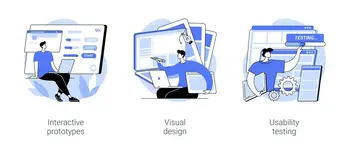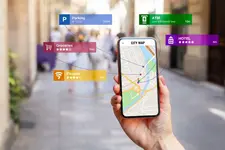
Table of contents
In recent years, many people have talked about the impact of interactive design on e-commerce. With more and more online stores, it is important for businesses to make their website stand out and match today’s design trends. Interactive web design can help achieve this by giving customers a unique experience.
A study showed that in 2022, the average
cart abandonment rate was 78.1%
. This means that only 3 out of 10 customers will complete a purchase. One reason for this is a bad user experience. Interactive websites can help improve the user experience and make it more likely that a customer will complete a purchase. For example, AI-powered chatbots can help customers find what they are looking for quickly.
Interactive website features can also help build trust between a store and its customers. By providing a secure HTTPS connection, customers can trust that their personal information is safe. Interactive design can also help businesses create a personalized experience for their customers. This can lead to more loyal customers and repeat business. As an
article
in MDPI said, a product configurator based on flow theory can give customers a positive customized experience.
What is Interactivity in e-Commerce

Interactivity in e-commerce is when online shopping websites have features that make it fun and interesting to use. This is different from old websites that were just static pages of text and pictures. Interactive e-commerce websites let users do things like:
- Zoom in on product images
- Read customer reviews
- Compare products side-by-side
- Ask questions to customer service
These features make the shopping experience more like what it would be in a physical store. Users can interact with the products and get help from real people, which makes them more likely to buy something.
Key Aspects of Interactivity in E-commerce
Visual Engagement:
Visuals are important in interactive e-commerce design. They use things like animations, videos, and graphics to keep users interested and help them navigate through the shopping experience. These visuals can highlight important products, features, and promotions, making the shopping experience more engaging and informative. That added appeal positively influences consumer psychology to make a purchase.
User-Driven Navigation:
User-driven navigation is an important part of e-commerce website design. It makes shopping easier and more enjoyable by letting people find what they want quickly and easily. This is done with interactive tools like drop-down menus, filters, and search boxes. These tools let people choose what they want to see and how they want to see it. This user-centred approach makes it easy to find the right products and helps people explore and discover new items.
Personalisation:

E-commerce platforms can use interactivity to collect information about what users do on their sites. This information can be used to make personalized recommendations for products that users might like. These personalized recommendations can help users find the products they are looking for faster and easier. They can also help users discover new products that they might not have found otherwise. This can make the shopping experience more enjoyable and rewarding for users.
Virtual Try-On and AR:
Augmented reality (AR) technology can be used in e-commerce to let customers try on clothes, accessories, and cosmetics before they buy them. This is a new way to shop online that helps people feel more confident about their purchases. AR can also be used to show customers how products will look in their homes or on their bodies. This can help people make better decisions about what to buy and can also make shopping more fun. AR is a great way to improve the e-commerce experience and to connect with customers on a deeper level.
Gamification:

Adding games to e-commerce websites, like quizzes, contests, and rewards, can make shopping more fun and interesting. This can keep people engaged and encourage them to look at more products and services. Gamification can also motivate people to explore different offerings, which can make the shopping experience more enjoyable. This can make the website more appealing and interactive.
User Reviews and Social Sharing:
User reviews and social sharing are important parts of e-commerce design. They allow customers to share their opinions about products and services with others, which can help other customers make informed decisions about their purchases.
User reviews can be in the form of text, ratings, or comments. They can be positive, negative, or neutral. When customers see reviews from other people, they can get a better idea of what to expect from a product or service. This can help them decide whether or not to buy something.
Social sharing allows customers to share reviews and other content about products and services on social media. This can help to spread the word about a product or service to a wider audience. It can also help to build excitement and anticipation for a new product release.
The combination of user reviews and social sharing can be a powerful tool for e-commerce businesses. It can help to increase brand awareness, drive traffic to a website, and boost sales.
Here is a more specific example of how user reviews and social sharing can be used in e-commerce:
- A customer buys a new pair of shoes from an online retailer. She loves the shoes and writes a positive review on the retailer’s website. She also shares the review on her social media accounts, tagging her friends and family.
- Her friends and family see the review and are interested in buying the shoes themselves. They click on the link to the retailer’s website and make a purchase.
- The retailer’s website gets more traffic and sales as a result of the positive review and social sharing.
This is just one example of how user reviews and social sharing can be used to benefit e-commerce businesses. By empowering customers to share their opinions and experiences, businesses can create a more interactive and engaging shopping experience for their customers.
Real-Time Support:

Real-Time Support is very important for e-commerce websites. It allows users to get help right away with their questions, either through live chat or a chatbot. This makes the shopping experience much smoother and more efficient, because users can quickly get their problems solved. Real-Time Support also helps users make better decisions, because they have all the information they need right away. This leads to more confidence in their choices and a better overall experience with the e-commerce website.
Here are some specific examples of how Real-Time Support can be used on e-commerce websites:
- A user can use live chat to ask a question about a product. A customer service representative can then answer the question right away.
- A user can use a chatbot to get information about a product. The chatbot can answer common questions about the product, or it can direct the user to a customer service representative if the question is more complex.
- A user can use Real-Time Support to troubleshoot a problem with their order. A customer service representative can help the user figure out what is wrong and how to fix it.
Real-Time Support is a valuable tool for e-commerce websites. It can help to improve the shopping experience for users and make them more likely to return to the website.
Dynamic Content:

Changing the content on a website often, like adding new banners, deals, and featured products, is important to keep people interested. This makes the website more exciting and fresh, which makes people want to come back more often. Highlighting new items and limited-time offers gets people curious and makes them want to explore the website more, which helps them find the latest products.
Multi-Device Compatibility:
Making interactive designs compatible with multiple devices is important to create a smooth and enjoyable user experience on different platforms, like computers, phones, and tablets. By carefully adjusting interactive elements to fit different screen sizes and features, e-commerce platforms make sure that users can easily use them no matter what device they choose. This approach not only keeps the visual look and functionality consistent but also respects users’ preferences and habits. It allows them to access, explore, and interact with the platform in a natural and easy way, which increases overall satisfaction and encourages continued use.
In e-commerce, interactivity is more than just browsing and buying. It’s about getting customers involved, encouraging them to explore, and creating a connection between them and the brand. Interactive elements like product videos, quizzes, and live chat can make online shopping more fun and engaging, and they can also help customers make better decisions. This can lead to increased sales and customer loyalty.
The Importance of Interactive Design in E-commerce
Interactive design has become an essential aspect of e-commerce websites. It is a design approach that focuses on creating engaging and interactive experiences for users. This section will explore the importance of interactive design in e-commerce, including its impact on user experience, design strategy, and human-computer interaction principles.
1. User Experience

Interactive design plays a crucial role in enhancing user experience on e-commerce websites. By providing users with an interactive and engaging experience, it increases satisfaction and loyalty. According to a study, 17% of online shoppers abandon their shopping carts due to a complicated checkout process. Interactive design can simplify the checkout process, making it more user-friendly and increasing conversion rates.
2. Design Strategy
Interactive design is an essential part of the design strategy for e-commerce websites. It helps to create an information system that is easy to navigate, with a clear hierarchy and layout. By using interactive design, retailers can customize their websites to suit their visitors’ needs and preferences. This personalization increases engagement and purchase intention.
3. Engagement Redefined
Interactive design breathes life into static digital spaces, turning them into captivating and immersive environments. By employing engaging visuals, animations, and interactive elements, e-commerce platforms captivate visitors’ attention, holding it for longer durations. This heightened engagement leads to increased exploration of products and content, ultimately translating into higher conversion rates.
4. Personalization and Relevance
In the age of data-driven insights, interactive design allows for personalised experiences. By analysing user behaviour, preferences, and purchase history, e-commerce platforms can deliver tailor-made product recommendations. This personalised touch not only enriches user experiences but also significantly boosts the likelihood of conversions.
5. Visual Storytelling

Interactive design enables e-commerce platforms to tell compelling brand stories visually. Through multimedia presentations, animations, and interactive product displays, brands can showcase the uniqueness and value of their offerings. This not only fosters brand recognition but also establishes an emotional connection with customers.
6. Augmented Reality (AR) Integration
The integration of AR technology in interactive design takes the shopping experience to a new level. Customers can virtually try on products, see how they fit into their lives, and make informed decisions. This immersive feature eliminates uncertainties associated with online purchases, resulting in higher customer satisfaction and fewer returns.
7. Reduced Bounce Rates
Interactive design mitigates the risk of visitors quickly leaving the website, a phenomenon known as ‘bounce.’ By offering engaging and relevant content, interactive elements encourage users to stay longer, explore deeper, and become more invested in the e-commerce platform.
8. Gamification and Incentives

Injecting gamified elements like quizzes, challenges, and rewards injects an element of fun into the shopping experience. This not only keeps users entertained but also encourages them to actively participate, ultimately leading to increased time spent on the platform and a higher chance of making purchases.
9. Social Sharing and Community Building
Interactive design facilitates social interactions within the e-commerce ecosystem. Users can share their experiences, recommendations, and purchases, creating a sense of community around the brand. This user-generated content enhances brand credibility and fosters word-of-mouth marketing.
10. Differentiation and Innovation
In a competitive e-commerce landscape, interactive design serves as a differentiator. Brands that invest in innovative and interactive elements stand out, capturing the attention of modern, tech-savvy consumers who seek engaging and memorable online shopping experiences.
11. Future-Proofing E-commerce
As technology continues to evolve, interactive design remains adaptable and relevant. It can seamlessly incorporate emerging technologies, such as virtual reality, voice interfaces, and more, ensuring that e-commerce platforms stay on the cutting edge and continue to provide exciting user experiences.
In conclusion, interactive design is not a mere trend but a transformative approach that adds immense value to e-commerce ventures. By fostering engagement, personalisation, visual storytelling, and innovation, interactive design propels e-commerce platforms towards success by creating meaningful connections with customers, elevating their experiences, and shaping the future of online retail.
Human-Computer Interaction Principles

Human-computer interaction principles are essential to the success of interactive design in e-commerce. These principles focus on creating a user interface that is functional, user-friendly, and aesthetically pleasing. Interactive design incorporates these principles to create a flow experience that enhances the user’s attitude and involvement.
Interactive design has become even more crucial during the COVID-19 pandemic. With more people shopping online, retailers need to create a convenient and accessible purchasing process. Interactive design can help to streamline the purchase process, making it easier for users to make online purchases.
According to a survey by Adobe,
38% of online shoppers
will leave a website if they find the layout unattractive. Interactive design can improve the aesthetics of e-commerce websites, making them more appealing to users. It can also increase revenue by improving the online sales process.
Interactive design is not just limited to e-commerce websites. Social media platforms like Taobao have also incorporated interactive design to enhance the customer experience. By collecting data on user behavior, interactive e-commerce can create a more personalized experience for users.
In conclusion, interactive design is an essential aspect of e-commerce websites that enhance the user experience, improves design strategy, and incorporates human-computer interaction principles. It has become even more crucial during the COVID-19 pandemic, as retailers need to create a convenient and accessible purchasing process. Interactive design can improve the aesthetics of e-commerce websites and increase revenue by improving the online sales process.
The Impact of Interactive Design on Online Sales
Interactive design has become an essential aspect of e-commerce websites, with businesses using it to improve their online sales. This section explores the impact of interactive design on online sales and how it affects revenue, the checkout process, and purchasing process.
i. Revenue

Interactive design has been shown to have a positive impact on revenue. According to a study by PLOS , interactive advertising increases consumer engagement and decision-making, leading to higher sales. Additionally, e-commerce has been shown to complement traditional sales, rather than replacing them entirely, resulting in a 7-10% increase in total sales for consumer electronics products.
ii. Checkout Process
Interactive design has also been shown to improve the checkout process, making it easier and more enjoyable for customers to complete their purchases. A study by INFORMS found that consumers who use interactive media, such as the World Wide Web, for pre-purchase information search and online shopping, have a higher likelihood of completing their purchases. Interactive design elements, such as progress bars and real-time feedback, can help customers feel more in control of the checkout process.
iii. Purchasing Process
Interactive design can also improve the overall purchasing process, making it more engaging and enjoyable for customers. A study by
Springer
found that interactive experience design can increase customer satisfaction and loyalty. Livestreaming, for example, has become a popular way for businesses to interact with customers and showcase their products. Livestreaming allows customers to ask questions and receive real-time feedback, making the purchasing process more interactive and engaging.
Interactive design can also help customers make more informed purchasing decisions. A
study
found that interactive design can be used as a conversion rate optimization tool, increasing the likelihood of customers making purchases. Interactive design elements, such as product comparison tables and user-generated ratings and reviews, can help customers make more informed decisions.
In conclusion, interactive design has a significant impact on online sales, improving revenue, checkout process, and purchasing process. Businesses that incorporate interactive design into their e-commerce websites are more likely to see increased sales and customer satisfaction.
The Role of Interactive Design in Building Trust
Interactive design plays a crucial role in building trust between e-commerce businesses and their customers. Trust is a key factor in the success of any e-commerce business, and interactive design can help achieve it. In this section, we will discuss how interactive design can help build trust and improve accessibility for e-commerce businesses.
(a) Trust

Trust is a critical factor in e-commerce. Customers need to trust the business they are buying from, and interactive design can help build that trust. A well-designed website can help customers feel confident in their purchases and make them more likely to return. According to a study by Baymard Institute,
18% of US online shoppers
abandoned their purchase due to a lack of trust in the website.
Interactive design can help build trust in several ways. One way is through the use of user-generated content, such as reviews and ratings. Customers are more likely to trust the opinions of other customers than the business itself. Another way is through the use of security badges and trust seals, which can help customers feel confident that their personal information is safe.
(b) Accessibility
Accessibility is another essential factor in e-commerce. A well-designed website should be accessible to all customers, regardless of their abilities. According to a study by the World Health Organization,
over 1 billion people
worldwide have a disability, and they are often overlooked in the design of e-commerce websites.
Interactive design can help improve accessibility by making websites more user-friendly. For example, adding alt tags to images can help visually impaired customers understand what is on the page. Using clear and concise language can help customers with cognitive disabilities understand the content. Interactive design can also help improve the overall user experience, making it easier for all customers to navigate the website.
In conclusion, interactive design plays a crucial role in building trust and improving accessibility for e-commerce businesses. By using user-generated content, security badges, and trust seals, businesses can help build trust with their customers. By making websites more user-friendly, businesses can improve accessibility for all customers.
The Future of Interactive Design in E-commerce

Interactive design has already made a significant impact on the e-commerce industry, and it is only going to become more important in the future. As technology advances and consumer preferences evolve, e-commerce businesses must adapt to stay competitive. In this section, we will explore the future of interactive design in e-commerce, focusing on AI, personalization, and logistics.
1. AI
Artificial intelligence (AI) is already being used in many e-commerce applications, from chatbots to product recommendations. In the future, AI will become even more prevalent, allowing e-commerce businesses to provide more personalized and efficient experiences for their customers.
For example, AI-powered virtual shopping assistants can help customers find the products they need more quickly and easily. These assistants can also use data from previous purchases to make personalized recommendations and offer discounts or promotions.
2. Personalization
Personalization is another area where interactive design will continue to have a significant impact. Customers are increasingly looking for personalized experiences, and e-commerce businesses that can deliver them are more likely to succeed.
One way to personalize the e-commerce experience is through targeted advertising. By using data on customer preferences and behavior, businesses can create ads that are more relevant and engaging.
Another way to personalize the experience is through product recommendations. By analyzing customer data and behavior, e-commerce businesses can suggest products that are more likely to appeal to individual customers.
3. Logistics
Finally, logistics is an area where interactive design will continue to play a crucial role. As e-commerce businesses continue to grow, they must find ways to streamline their operations and improve efficiency.
One way to do this is through the use of smart warehouses. By using sensors and other technology, warehouses can optimize their layouts and processes, reducing the time it takes to pick and pack orders.
Another way to improve logistics is through the use of delivery drones. While this technology is still in its early stages, it has the potential to revolutionize the way e-commerce businesses deliver their products.
In conclusion, the future of interactive design in e-commerce looks bright. As technology continues to advance, businesses that can provide personalized, efficient experiences for their customers will be more likely to succeed. By embracing AI, personalization, and logistics, e-commerce businesses can stay ahead of the curve and continue to grow in the years to come.


















